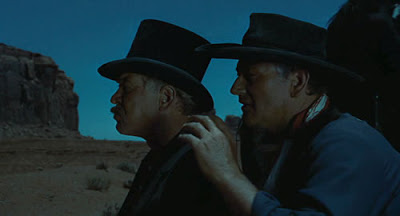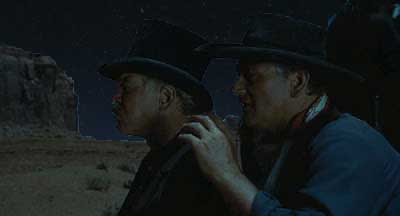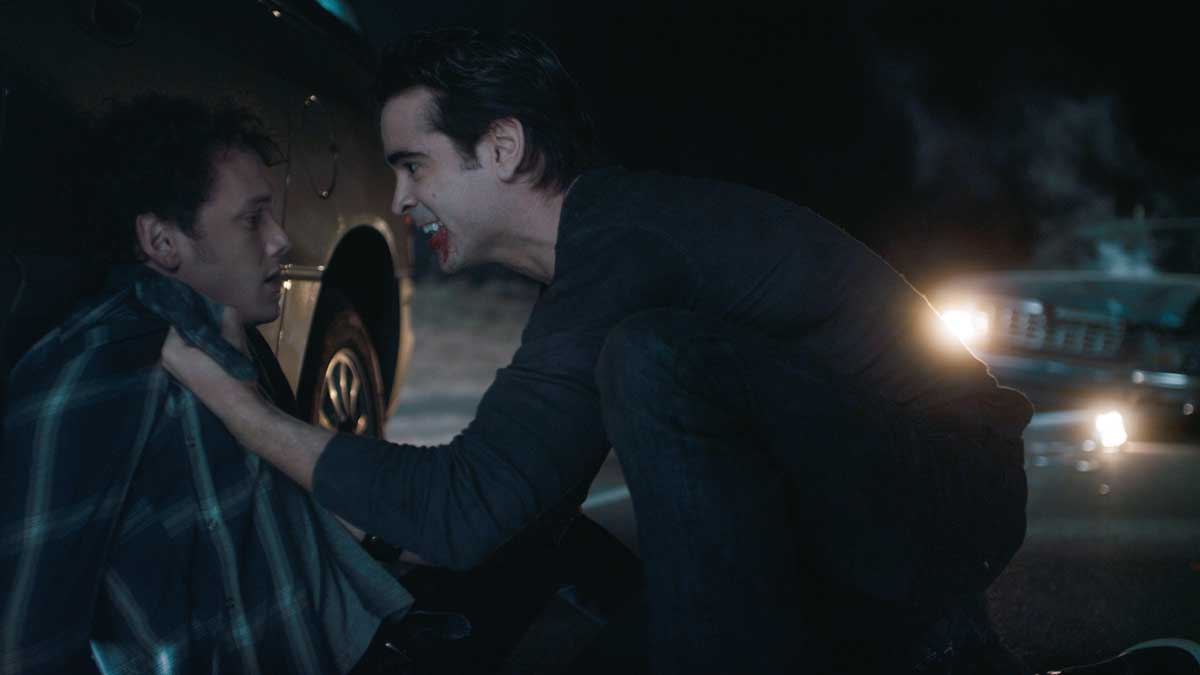Can You Change Warm Footage To Cool To Make It Look Like Night?
Twenty-four hours for Night: How to Make Daytime Shots look like Nighttime
Shooting what is usually known in the industry as "day for night" has been a fob used for decades. The method involves shooting in the daytime under sunlight. Then the task is to make it expect as close to possible as night using various techniques.
Even if you lot've never heard of it earlier, you will nearly certainly accept seen it used, in TV shows and film. Solar day for Nighttime was used so often by Hollywood, especially in lower budget movies and westerns that information technology became known in France as "nuit américaine" ("American nighttime").

This technique oftentimes has variable results. Sometimes the effect looks no more disarming than daytime but with the exposure reduced.
One telltale sign a scene has been filmed using "day for night" is when everything is night except the heaven. Run across what I mean in the prototype in a higher place taken from a John Wayne western. Beneath I really quickly (and badly) replaced the heaven with a dark sky using photoshop.

Simply past replacing the sky, the illusion of night is much stronger. Replacing the sky in the 1950s and 60s was a lot harder than information technology is now, with digital editing techniques affordable to many.
Creating the illusion
Filmmaking is all about creating the illusion of reality. This doesn't necessarily mean recreating reality. In fact information technology means creating a kind of poetic impression of reality.
If yous've ever witnessed a real fistfight, you will know human fists hitting human chins don't make the exaggerated sound we hear in movies. Rather, filmmakers endeavour to recreate something which "feels" existent to the audience. And the same applies to trying to brand day look similar night.
I had to shoot a 24-hour interval for nighttime scene in my feature movie Third Contact. While I managed to underexpose the shot enough to brand the actors look like they might just be outside at nighttime, the heaven came out almost vivid white past contrast.
To attempt to reduce that effect, nosotros shot during twilight (the moment but afterward the sun has dipped backside the horizon). But as shortly as the sky came into shot, it was obvious is was day.
So when I shot the scene, I tried to proceed the heaven out of shot. We were in a park surrounded by trees, so angles filled with trees in the groundwork were fix up. I also took some higher shots, angled down so that the sky was merely above the top of the frame.
What does night look like?
While we can't (and probably don't want to) replicate how our eyes experience night, nosotros tin can get inspiration from reality. A lot will depend on the scene and the lighting. If there's artificial light similar flashlights or streetlights, that is going to modify how things expect.
Just if nosotros are trying to recreate elementary ambient low-cal, from stars, moon or distance light sources so we might await at these elements:
- deeper shadows – bigger and with less detail
- reduce the size and brightness of the highlights
- reduce warm colours (red) and boost cold (blue)
- higher or lower contrast?
Shooting for Day for Nighttime
These are the camera settings you can adjust when shooting day for nighttime. Getting the paradigm closer in photographic camera gives you a bit of a head start. The less yous have to crook things in the form the ameliorate.
Underexpose
Make certain to shoot your scene with the camera prepare to underexpose the image. This means highlights won't be blown out. And then work out how to film with the exposure under what would be acceptable if you wanted it to look similar day.
Depending on your photographic camera, y'all might need to use ND filters. This is to reduce the lite reaching the sensor without having to increment shutter speed higher up the "picture look" setting. For example: 24 fps and ane/48th shutter speed.
Don't go too far and remove too much information from the paradigm. You simply want to make sure the highlights are non clipping or called-for out.
More than blue
Using your white remainder settings, endeavor to give your paradigm a look which is more blue than would be for a daylight scene.
Backlight your subjects
When you are shooting in wide daylight, the actors will have difficult shadows on their faces. This is another giveaway inkling when watching scenes shot twenty-four hour period for night.
Exit with a friend under a moonlit sky and see how brightly lit their face is. You'll see that moonlight creates a gentle, soft lite. This is like the departure between having the overhead lights on in a room or using a couple of candles.
This is a good indicate, considering it reminds us filmmaking is all about creating a feeling. Moonlight and candlelight are both considered essential for a romantic scene. But full midday sunlight doesn't feel as romantic.
Then, one option is to position your actors with their backs to the dominicus to soften the light on their faces. Yous aim is to create a prissy "rim light" on the actors, which will be easier adjust to wait like moonlight when grading.
Shoot during golden hour
Equally mentioned above, shooting at twilight provides a softer low-cal which is closer to moonlight. In fact, it's literally closer to night as well as in lighting terms.
Typically, grading twilight to look like nighttime is much simpler than doing so with full daylight footage. Even so, y'all will nevertheless need to work around framing – a lower sun is more than probable to appear in shot. Also, a lower sun will create longer shadows which you might not want for creative reasons.
Use a polarizer
Past using a polarizer you can cut out those cogitating glares which give y'all away. A polarizer will give you more control over the harsh appearance of the daylight. The filter also reduces the amount of light too, which helps you to (slightly) underexpose the image.
Grading Solar day for Night
Shooting twenty-four hour period for night is only half the task. Luckily, these days we have the power of digital grading software to assist united states practise an fifty-fifty better job turning day into nighttime.
Call up, film is 1) creative and poetic – this isn't about reality, merely the impression of reality to convey a feeling to the audience. And ii) an illusion – they say the aim of a filmmaker is to get the audition to "append their disbelief". This is non the same equally believing what they are seeing is reality.
You are aim is to seduce your audience into accepting your film's version of reality. And so annihilation which pulls them out of this seduction is to be avoided. That's why consistency is so important.
Once you have established the look (ie: the rules of this world) endeavor to maintain it throughout the entire night scene. If in 1 shot the actors have nice soft lighting, and so in the next at that place'southward harsher more daylight similar lighting, it volition jar the audience out of the scene. They'll then outset to question reality – "hey, this is day for nighttime!"
Adjust exposure
You can adjust the exposure however farther, bringing downwardly the highlights. Now, how much detail exercise you desire to retain in the faces of the actors? Practice y'all want silhouettes, most silhouettes or just full general soft low-cal across their faces?
When you reduce highlights yo starting time to lose particular. However, you can counter this by raising the mid tones. If your image is now too flat, crush the backs to bring dorsum contrast.
Adjust colour and saturation
Generally speaking, this involves pushing blue/magenta into the highlights and the shadows. Adjacent, desaturate the unabridged paradigm. Cool tones should work well with the slightly underexposed footage and start to generate that convincing day for night wait.
Contrast
Reducing contrast gives yous a smoother more moonlight-like wait. Nevertheless it can also make the prototype wait flat and grey – not very romantic!
That's why some subtle but brighter light catching the edges of faces can create something more visible, more contrasty, but at the same time give a feeling of night.
This will all depend on what you lot are trying to achieve and what you managed to movie. If y'all managed to film with some dorsum lighting, then this might help you out at this phase.
Replace the sky
These days, software such as Adobe Later Effects allows us to do simple compositing relatively easy. This means, unlike those 1960s b movie westerns, nosotros can try to replace the sky. This will exist much easier if your camera isn't moving (or just slowly and smoothly).
This YouTube tutorial by Tom Antos walks you through his whole solar day for night procedure, include sky replacement.
I recollect I would go for deeper shadows if yous truly want the shot to look like dark. Aye you lose a lot of detail from the image, simply that's what dark looks like to the homo eye. We just not very proficient at seeing in the dark.
The problem with the scene in this tutorial is the desert groundwork looks generally quite bright. To expect more than similar night, that sand would be better appearing mostly black. Perhaps a few subtle highlights picking out some edges here and there.
What are your thoughts?
What are the best nighttime scenes you've seen in a picture? I would definitely recommend getting inspiration from those, even if they're not twenty-four hours for night.
I call up it's a very tricky thing to go right. I ofttimes see movies where I recall, "Where's all that light coming from? Is that supposed to be moonlight?"
So, even shooting at night with a full crew and lights filmmakers are yet faking it. When moonlight is replaced by large powerful lights it doesn't wait realistic. But there's a reason for doing this and that's because filmmakers take to think near their audience.
The truth is, for commercial purposes, filmmakers might need to over-calorie-free a dark scene. It might just be budget and a risk reduction attitude (amend nosotros run across more than less). Or it might be a lack of top cinematography skills.
For me, the nearly important thing is the correct mood and feeling is created. This is not reality, this is picture show reality. Merely we too desire to avoid snapping people out of the movie. And that happens when it's glaringly obvious that a night scene is not shot at dark.
Have a expect at this image below from the movie Fright Dark (2011). This is not mean solar day for night, but it'south a good example of a scene shot at night and having to "cheat" sure things.
To me, having a nighttime background goes a long manner to creating the illusion of dark. The vivid headlamp contrast with the surrounding background making it look darker.
Meanwhile, the actors are well lit in the foreground without harsh shadows. This is not how this would expect in reality. Their faces are far to well lit.
And where is that light on the actors coming from in the scene? Well, beingness logical, just from a perfectly ready film light. At that place is no source in the scene for that light.
So this is a good case of how filmmakers are operating between existent and realistic. The director and DoP accept decided to abandon reality here and calorie-free the actors so the audience can clearly see their expressions. But they've done it in a way which probably won't take the audition out of the scene.
Smartphone Video – Beginner to Advanced
If you want to know more about smartphone filmmaking, my volume Smartphone Videography – Beginners to Avant-garde is now available to download for members on Patreon. The book is 170 pages long and covers essential smartphone filmmaking topics:
Things similar how to get the perfect exposure, when to utilize manual control, which codecs to use, HDR, how to use frame rates, lenses, shot types, stabilisation and much more. There's also my Exploring the Picture show Expect Guide as well as Smartphone Colour Grading.
Members can also admission all 5 episodes of our smartphone shot Silent Eye series, with accompanying screenplays and making of podcasts. There's other materials likewise and I will be calculation more in the future.
If yous want to join me there, follow this link.

Source: https://momofilmfest.com/day-for-night-how-to-make-daytime-shots-look-like-nighttime/
Posted by: burgessanist1997.blogspot.com


0 Response to "Can You Change Warm Footage To Cool To Make It Look Like Night?"
Post a Comment